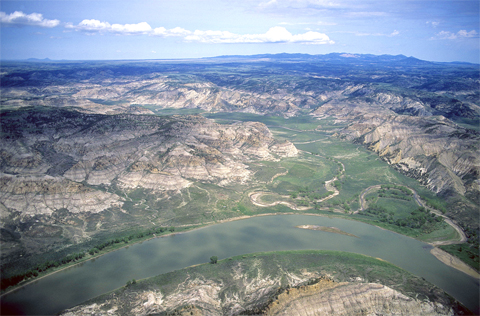Lewis and his group paddle “faithfully” through the Upper Missouri River Breaks moving at about seven miles per hour. They stop often to hunt and bag two bison, one elk, two beaver, and a female grizzly bear.
Clark and his group paddle down the Yellowstone but must stop for a “violent Storm” and to line their dugouts through the ‘Buffalo Shoals’. Clark observes great quantities of red stone—clinker—at the mouth of the Powder River.
Without horses, Sgt. Pryor and his three men must paddle their two leather bull boats with vigor if they are to catch up with the expedition.[1]For more on the captains’ strategy and various groups after leaving Travelers’ Rest, see Dividing Forces at Travelers’ Rest.
Lewis Through the Breaks
Faithful Paddles and Oars
The rain still continued this morning it was therefore unnecessary to remain as we could not dry our baggage I Consequently set out early as usual and pursued my rout downwards. the currant being strong and the men anxious to get on they plyed their oars faithfully and we went at the rate of about seven miles an hour.
—Meriwether Lewis
Good Hunting
we halted several times in the course of the day to kill some bighorns being anxious to procure a few more skins and skeletons of this animal; I was fortunate enough to procure one other malle and female for this purpose which I had prepared accordingly. seven others were killed by the party also 2 buffaloe one Elk 2 beaver with & a female brown bear with tallons 6¼ inches in length.
—Meriwether Lewis
All Day Rain
we arrived this evening at an island about 2 ms. above Goodriches Island and encamped on it’s N. E. side. the rain continued with but little intermission all day; the air is cold and extreemly disagreeable. nothing extraordinary happened today
—Meriwether Lewis
Weather Diary (Lewis)
State of the weather at rise
Wind at rise
State of the weather at 4 P. M. Wind at 4 P. M. rain after rain N E rain N E rained almost without intermission
—Meriwether Lewis
Clark at the Powder River
Yellowstone and Powder River Confluence
© 27 July 2011 by Kristopher K. Townsend. Permission to use granted under the Creative Commons Attribution-Share Alike 4.0 International license.
Above: the line of cottonwood trees coming from the right outline the banks of the Powder River.
Buffalo Shoals
we were Compeled to let the Canoes down by hand for fear of their Strikeing a rock under water and Splitting . . . . a Perogu or large Canoe would with Safty pass through the worst of those Shoals, which I call the Buffalow Sholes from the Circumstance of one of those animals being in them.
—William Clark
York’s Dry River
a violent Storm from the N. W. obliged us to land imediately below this rapid, draw up the Canoes and take Shelter in an old Indian Lodge above the enterance of a river which is nearly dry it has laterly been very high and Spread over nearly ¼ a mile in width. its Chanel is 88 yards and in this there is not more water than could pass through an inch auger hole. I call it Yorks dry R.
—William Clark
The Redstone (Powder) River
I observe great quantities of red Stone thrown out of this river that from the appearance of the hills at a distance on its lower Side induced me to call this red Stone river. [Nicholas Biddle: By a coincidence I found the Indian name Wa ha Sah]
—William Clark
Weather Diary (Clark)
State of the weather at Sun rise Wind at Sun rise State of the weather at 4 P. M Wind at 4 P M. fair after rain thunder lightning N. W. fair after rain S. E a fiew drops of rain accompanied with hard Claps of Thunder and Sharp lightning last night wind hard from the N. E.
—William Clark[2]To assist the reader of this web page, the date column is omitted and some abbreviations have been spelled out.
Bull Boat
Display at Pompeys Pillar National Monument, U.S. Bureau of Land Management. Photo 2017 by Kristopher K. Townsend.
Pryor’s Leather Boats
[The bull boats] were made in the following manner. Viz: 2 Sticks of 1¼ inch diameter is tied together So as to form a round hoop of the Size you wish the canoe, or as large as the Skin will allow to cover, two of those hoops are made one for the top or brim and the for the bottom the deabth you wish the Canoe, then Sticks of the Same Size are Crossed at right angles and fastened with a throng to each hoop and also where each Stick Crosses each other.
—William Clark (recorded 8 August 1806)[3]Precise dates and locations for Pryor’s trip down the Yellowstone are not known. Pryor was instructed to keep a journal, but it if he did, it is lost.
Experience the Lewis and Clark Trail
The Lewis and Clark Trail Experience—our sister site at lewisandclark.travel—connects the world to people and places on the Lewis and Clark Trail.
Plan a trip related to July 30, 1806:
- Slaughter River Boat Camp (Lewis)
- Gist Bottom Boat Camp (Lewis)
- Billings to Yellowstone Confluence Driving Tour (Clark and Pryor)

Notes
| ↑1 | For more on the captains’ strategy and various groups after leaving Travelers’ Rest, see Dividing Forces at Travelers’ Rest. |
|---|---|
| ↑2 | To assist the reader of this web page, the date column is omitted and some abbreviations have been spelled out. |
| ↑3 | Precise dates and locations for Pryor’s trip down the Yellowstone are not known. Pryor was instructed to keep a journal, but it if he did, it is lost. |



